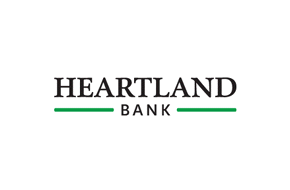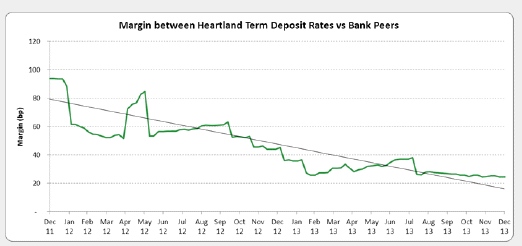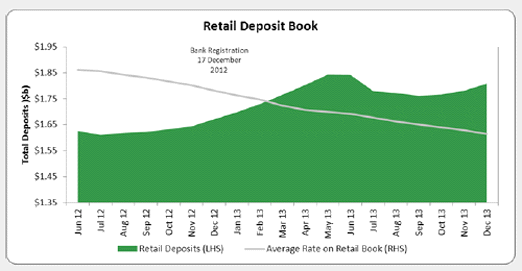
Heartland Bank has reported interim profit in line with its previous forecast and says it's confident future earnings won't be affected by its troubled non-core property portfolio. However, the bank expects asset growth to "remain challenging" due to increased competition in the business and rural sectors.
Lower funding costs, with the margin between its deposit rates and those of other banks falling, is also helping profit, Heartland says.
Net profit after tax for the six months to December 31 last year rose $6 million, or 56%, to $16.7 million from $10.7 million in the same period of the previous year. This was in line with the bank's guidance for profit of about $16.5 million.
Heartland says it has made significant progress in running down its troubled legacy non-core property book with these assets having no impact on its half-year earnings. The bank's half-year cost to income ratio of 55% was down from 60% in the year to June 2013, and 62% in the same period of the previous financial year.
Heartland has forecast June 2014 year profit of $34 million to $37 million. That compares with profit last year of just $6.9 million when its bottom line was savaged by a $24.3 million pre-tax hit from the write-down of its non-core property holdings.
The non-core property portfolio comprises loans and investment properties inherited from Marac Finance when the previously Pyne Gould Corporation (PGC) owned finance company merged with building societies CBS Canterbury and Southern Cross Building Society to create Heartland in January 2011.
Heartland says total legacy non-core property assets reduced 19% from $107.4 million at June 30 last year to $87.1 million at December 31. And as of December, non-core property assets comprised net receivables of $25.6 million and investment properties of $61.5 million.
"The exit strategy for non-core property assets has progressed in accordance with expectations and Heartland remains confident that future earnings will not be affected by these assets," Heartland says. CEO Jeff Greenslade recently told interest.co.nz "even the ugly stuff is actually shifting."
Heartland, which earlier this month announced plans to buy New Zealand and Australian reverse equity mortgage businesses Sentinel and Australian Seniors Finance for NZ$87 million, said the profit rise was helped by a reduction in its cost of funds. The bank says the margin between its term deposit rates and bank peers is closing (see charts below).


See all advertised bank term deposit rates for one to nine months here and for one to five years here.
Increased competition; Acquisitions still on radar
Heartland says competition has stepped up in the business and rural sectors, two of its three core target markets, meaning asset growth will "remain challenging."
"However, growth in “Households” through both motor vehicle and home equity release products looks strong. We will continue to focus on product substitution to improve net operating income, continued management of operating expenses and impairment levels as well as investigation of potential acquisition targets," Heartland says.
Heartland had the following to say on its three core business units;
Business
Net operating income (NOI) was $14.7m, an increase of $2.1m from the Previous Corresponding Reporting Period. The increase in NOI was driven by lower cost of funds. The business receivables book increased by $9.0m to $558.1m during the Current Reporting Period. The business division has faced increasing competitive pressure which has had an impact on asset growth over the Current Reporting Period.
Rural
NOI was $12.1m, an increase of $0.6m from the Previous Corresponding Reporting Period. The increase in NOI was also driven by lower cost of funds off-setting reduced revenue on fewer receivables. The rural receivables book decreased by $40.8m to $415.9m during the Current Reporting Period. This decrease was driven by reductions in the receivables book acquired from PGG Wrightson Limited, in areas of either higher risk or overlapping competition with major banks. Heartland’s emphasis is mainly on livestock lending with the pipeline looking good for the next few months. Livestock lending continued to perform well, growing 10.6% over the 12 months ended 31 December 2013.
Retail and Consumer
NOI was $30.0m, an increase of $5.9m from the Previous Corresponding Reporting Period driven primarily by lower cost of funds as well as increased revenues. The retail and consumer receivables book contracted by $49.7m to $938.1m during the Current Reporting Period. The motor vehicle receivables book grew $21.4m during the Current Reporting Period. In line with Heartland’s strategy to realign its product mix towards products where it has market leadership and can achieve a better risk/return, the residential mortgage book reduced by $71.1m during the Current Reporting Period. Customer response to the residential mortgage arrangement with Kiwibank has been pleasing. Greater than 50% of mortgages refinancing externally migrated to Kiwibank in the Current Reporting Period.
Heartland's total assets fell almost $143 million in the half-year to $2.49 billion, which the bank attributed to a $104.5 million reduction of non-core residential mortgage and property assets, plus a fall in non-core parts of its rural book such as high risk or lower yielding mortgage lending. Total liabilities were also down, $24.5 million, to $2.109 billion. This came as borrowings fell $20.6 million, or 1%, to $2.076 billion with deposits dropping $30.6 million, or 1.7%, to $1.805 billion.
Net interest income rose $5.6 million, or 12%, to $52.4 million, and net operating income gained $7.1 million, or 14%, to $58.9 million. Expenses rose $474,000, or 1.5%, to $32.4 million. Impaired asset expenses fell $1.9 million, or 37%, to $3.3 million.
Heartland says its net impaired, restructured and past due loans over 90 days reduced to $42.4 million, or 2.2% of net finance receivables at December 31, from $49 million or 2.4% of net finance receivables at June 30. Its non-core property book comprised $21.6 million of the net impaired, restructured and past due loans at December 31.
"The Net Impairment Ratio of the core business (excluding the non-core property book) was 1.1% as at 31 December 2013, compared to 0.9% as at 30 June 2013. This remains a low level of impairment across the book," Heartland says.
The only sharemarket listed New Zealand bank, Heartland will pay an interim dividend of 2.5 cents per share up from 2c a share. Its shares were up 1c, or 1.1%, at 91c, after the results announcement.
See Heartland's full release here, its financial statements here, and its presentation here.

We welcome your comments below. If you are not already registered, please register to comment.
Remember we welcome robust, respectful and insightful debate. We don't welcome abusive or defamatory comments and will de-register those repeatedly making such comments. Our current comment policy is here.